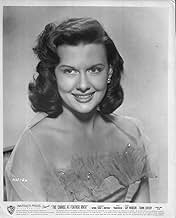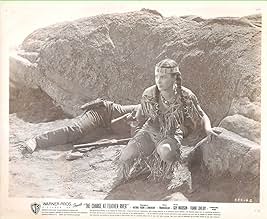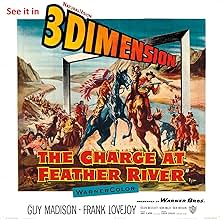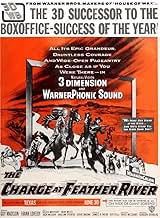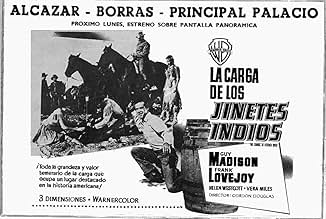Un destacamento de soldados de caballería, liderados por el sargento Baker y acompañados por el explorador Miles Archer, se adentra en territorio indio para liberar a dos hermanas que han si... Leer todoUn destacamento de soldados de caballería, liderados por el sargento Baker y acompañados por el explorador Miles Archer, se adentra en territorio indio para liberar a dos hermanas que han sido capturadas por los cheyennes.Un destacamento de soldados de caballería, liderados por el sargento Baker y acompañados por el explorador Miles Archer, se adentra en territorio indio para liberar a dos hermanas que han sido capturadas por los cheyennes.
- Dirección
- Guionista
- Elenco
- Dirección
- Guionista
- Todo el elenco y el equipo
- Producción, taquilla y más en IMDbPro
Opiniones destacadas
Warner Brothers produced this 3D extravaganza that was the biggest commercial success for westerns in 1953. Guy Madison leads a band of guardhouse soldiers and misfits to rescue two white women being held by Indians, which essentially all there is to this film. The 3D format was in its early stages as a Hollywood gimmick to compete with the growing popularity of home television, and the effects work very well here. The rescuers make off with the ladies and are pursued by the Indians until the white men make their stand at an island in a creek bed. The Indian weaponry comes at the audience non-stop throughout, and a spray of tobacco juice aimed at a rattler is thrown in for good measure. Madison was quite popular as television's Wild Bill Hickock and is good as a displaced cattle rancher who is given his thankless task by the army. For all the film's polish and presentation, the movie was made in just three days.
I saw this movie in its original 3-D run in 1953 and never forgot it. Roughly based the actual Battle of Beecher's Island in Colorado, it's pretty exciting stuff. Some say that this is the movie that killed 3-D with Frank Lovejoy spitting into the face of the audience. I don't know about that, but I do know that I enjoyed it then and enjoyed it again recently on cable. And then, of course, this is THE movie with the Wilhelm Scream, made famous by latter day maestros such as George Lucas. No DVD version released yet...maybe in the not-too-distant future. The love story is sort of stupid and the comedy bits are not very funny, but I know I enjoyed it more than The English Patient, or just about anything that Merchant-Ivory ever released. I suppose the movie was produced to take advantage of Guy Madison's high visibility as TV's Wild Bill, very popular with the kiddies at the time.
6bux
Slightly above average western drama with the emphasis on action. A cavalry commander (Madison) is forced to recruit from the guard house and set out on a mission to bring back white hostages the Indians have captured. All the expected sterotypes are present, and of course one of the hostages is a beautiful female. Since this one was originaly shot in 3D, be prepared to 'suffer those slings and arrows!'
The Charge At Feather River finds Guy Madison in charge of a group of misfit soldiers called the Guardhouse Brigade because that's where most of them were recruited for this mission from. The mission is to rescue two white women, Helen Westcott and Vera Miles, who were taken years ago during a raid and are now confirmed alive and now living with the Arapahoe.
The worst of his recruits is Neville Brand, but the rest of the crew that Madison has are no prizes with the exception of Lane Chandler who was a former Confederate officer who captured Madison during the Civil War. Along for comic relief are Dick Wesson and Henry Kulky who provide some levity in what is a serious film.
Vera Miles got her first real notice here. She's never been to Sweden, but she suffers from Stockholm syndrome as she now totally identifies with her captors. In fact she's going to be the bride of the chief, making him quite the envy of his tribe since none of them are married to any blonds. She acquits herself well in the part.
The film is loosely based on a real cavalry engagement in the Indian Wars, the battle of Beecher's Island. It combines elements of The Dirty Dozen and with John Ford's classic Two Rode Together.
And of course there's the 3-D which elicited a lot of excitement back in the Fifties. Even today seeing the various spears, tomahawks, and even some tobacco juice, courtesy of Frank Lovejoy, coming right at you on the small screen is impressive.
The Charge At Feather River still holds up well today, but should really be seen at a movie theater.
The worst of his recruits is Neville Brand, but the rest of the crew that Madison has are no prizes with the exception of Lane Chandler who was a former Confederate officer who captured Madison during the Civil War. Along for comic relief are Dick Wesson and Henry Kulky who provide some levity in what is a serious film.
Vera Miles got her first real notice here. She's never been to Sweden, but she suffers from Stockholm syndrome as she now totally identifies with her captors. In fact she's going to be the bride of the chief, making him quite the envy of his tribe since none of them are married to any blonds. She acquits herself well in the part.
The film is loosely based on a real cavalry engagement in the Indian Wars, the battle of Beecher's Island. It combines elements of The Dirty Dozen and with John Ford's classic Two Rode Together.
And of course there's the 3-D which elicited a lot of excitement back in the Fifties. Even today seeing the various spears, tomahawks, and even some tobacco juice, courtesy of Frank Lovejoy, coming right at you on the small screen is impressive.
The Charge At Feather River still holds up well today, but should really be seen at a movie theater.
Other commentators here have done an admirable job in addressing where "Charge at Feather River" fits in within the canon of Western movies, its similarity to "The Dirty Dozen" and other films of that genre, the use of 3-D effects, and even the origin of the Wilhelm scream. But what about the climactic, epic-making confrontation between Miles Archer (Guy Madison) and Chief Thunderhawk (Fred Carson)? In the action/adventure movies of the 1950s and 1960s, one knows the leaders will meet and fight it out. But when and where and how will it happen?
Thunderhawk has plenty of reasons to want to kill Archer himself. The whites are building a railroad through Cheyenne territory; their rescue effort has led to the death of Thunderhawk's bride-to-be. The cavalry troopers are occupying an island in the middle of the Feather River itself.
In the first charge, the Cheyenne have been repulsed. Their bodies float about the river. Stray horses amble about without direction. But the calm following this is deceptive. The Cheyenne prepare for another charge and this time Thunderhawk will personally take command.
At first, all goes well and a couple of the Guardhouse Brigade are picked off. Then, Thunderhawk commits his fatal mistake. At the head of about thirty to fifty braves, he veers off with only a half a dozen or so warriors to approach the island from the rear while the main bunch of Indians continues to hurl spears and to get shot, falling off their horses, and then bobbing in the river.
Thunderhawk, recognizable in his eagle feather headdress, leads his handpicked braves slowly up an embankment, on their bellies, in preparation for this "stealth" attack. But when they reach the crest of the embankment, above the river's edge, all goes wrong. They are seen too soon and all but Thunderhawk get shot down. Meanwhile, the main war party is beginning to back off.
Thunderhawk, without rifle or spear, cut off from all his men, draws his knife, preparing to do battle with Archer, one against one. Thunderhawk's very life now depends upon his skill with a knife. The bare-chested Cheyenne war chief, confident, powerful, motivated, eager for revenge and victory, squares off against Archer.
After only a few moments, Archer has maneuvered the chief to a slight earthen rise above the embankment, so that the daring, risk-taking, bold Cheyenne war chief stands a little bit above the cavalry officer. Archer goes for Thunderhawk's proud, taut, copper-bronze, native leader belly. As the knife goes in (off camera), Thunderhawk grunts in disbelief and topples, about to fall over the embankment. In a very clever shot, Guy Madison is seen looking over the embankment as Thunderhawk might have seen the view, his last before his death. Thunderhawk gives out a scream of terror as he tumbles down the embankment, splashing into the river. His horse makes way, only slightly, as the chief disappears under the water.
A valiant, determined, daring, native chief has lost his gamble.
Thunderhawk has plenty of reasons to want to kill Archer himself. The whites are building a railroad through Cheyenne territory; their rescue effort has led to the death of Thunderhawk's bride-to-be. The cavalry troopers are occupying an island in the middle of the Feather River itself.
In the first charge, the Cheyenne have been repulsed. Their bodies float about the river. Stray horses amble about without direction. But the calm following this is deceptive. The Cheyenne prepare for another charge and this time Thunderhawk will personally take command.
At first, all goes well and a couple of the Guardhouse Brigade are picked off. Then, Thunderhawk commits his fatal mistake. At the head of about thirty to fifty braves, he veers off with only a half a dozen or so warriors to approach the island from the rear while the main bunch of Indians continues to hurl spears and to get shot, falling off their horses, and then bobbing in the river.
Thunderhawk, recognizable in his eagle feather headdress, leads his handpicked braves slowly up an embankment, on their bellies, in preparation for this "stealth" attack. But when they reach the crest of the embankment, above the river's edge, all goes wrong. They are seen too soon and all but Thunderhawk get shot down. Meanwhile, the main war party is beginning to back off.
Thunderhawk, without rifle or spear, cut off from all his men, draws his knife, preparing to do battle with Archer, one against one. Thunderhawk's very life now depends upon his skill with a knife. The bare-chested Cheyenne war chief, confident, powerful, motivated, eager for revenge and victory, squares off against Archer.
After only a few moments, Archer has maneuvered the chief to a slight earthen rise above the embankment, so that the daring, risk-taking, bold Cheyenne war chief stands a little bit above the cavalry officer. Archer goes for Thunderhawk's proud, taut, copper-bronze, native leader belly. As the knife goes in (off camera), Thunderhawk grunts in disbelief and topples, about to fall over the embankment. In a very clever shot, Guy Madison is seen looking over the embankment as Thunderhawk might have seen the view, his last before his death. Thunderhawk gives out a scream of terror as he tumbles down the embankment, splashing into the river. His horse makes way, only slightly, as the chief disappears under the water.
A valiant, determined, daring, native chief has lost his gamble.
¿Sabías que…?
- TriviaWILHELM SCREAM: A scream used for the character Private Wilhelm (recorded originally for Eco de tambores (1951)), can be heard when he is shot in the leg by and arrow and painfully lets out a Wilhelm. This famous sound effect has since been re-used in many films, including the Star Wars, The Lord of The Rings and Indiana Jones films.
- ErroresWhen Morgan sets Jennie free, she takes his revolver and then falls from the cliff, taking his revolver with her. In subsequent shots, however, Morgan has a pistol again.
- ConexionesFeatured in Nace una estrella (1954)
Selecciones populares
Inicia sesión para calificar y agrega a la lista de videos para obtener recomendaciones personalizadas
- How long is The Charge at Feather River?Con tecnología de Alexa
Detalles
Taquilla
- Total en EE. UU. y Canadá
- USD 3,650,000
- Tiempo de ejecución1 hora 35 minutos
- Relación de aspecto
- 1.37 : 1
Contribuir a esta página
Sugiere una edición o agrega el contenido que falta

Principales brechas de datos
By what name was The Charge at Feather River (1953) officially released in India in English?
Responda

